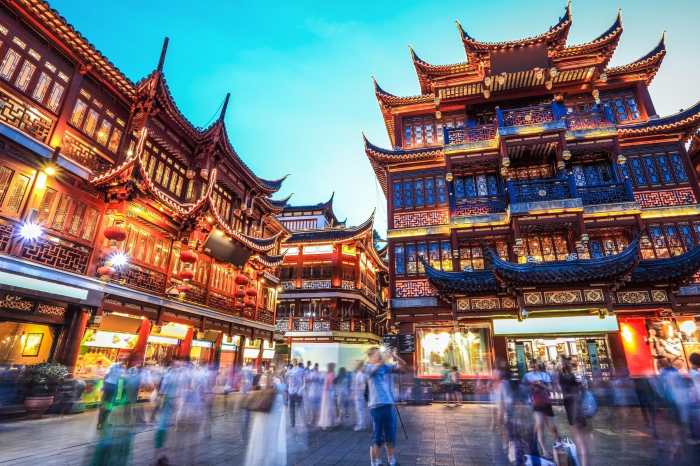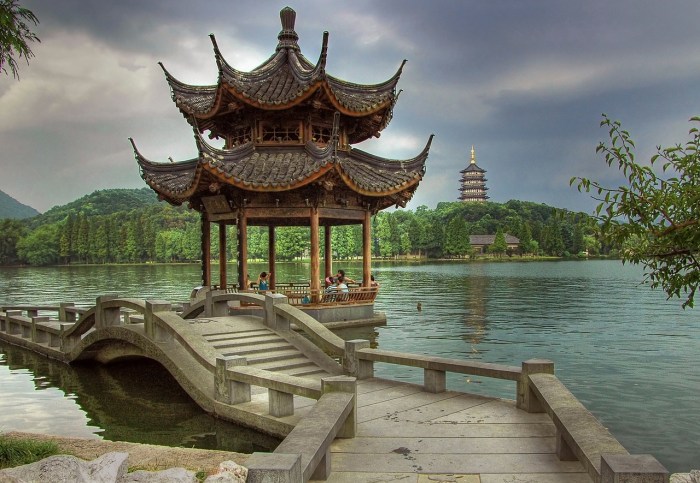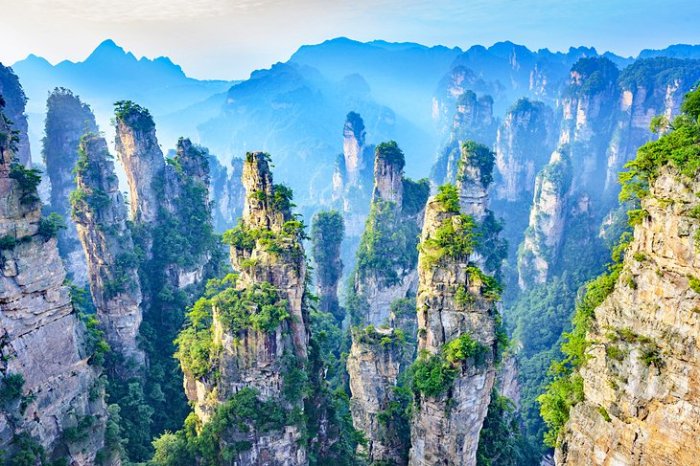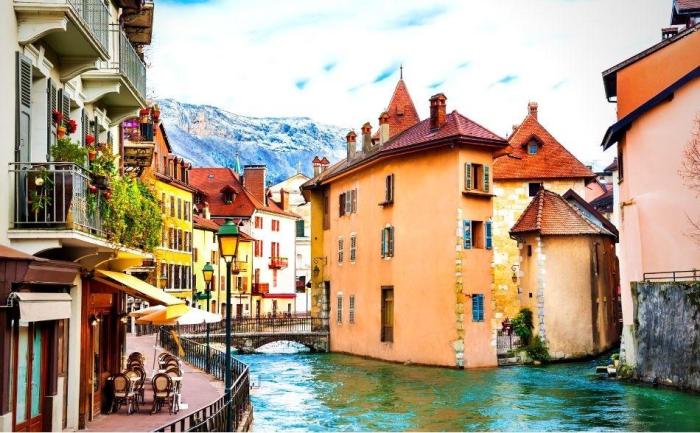Top 10 Places To Visit In China
Top 10 Places To Visit In China: From the majestic Great Wall to the serene gardens of Suzhou, China offers a breathtaking tapestry of history, culture, and natural wonders. It’s a land where ancient traditions meet modern marvels, where bustling cities coexist with tranquil landscapes.
Whether you’re drawn to the grandeur of imperial palaces or the serenity of ancient temples, China promises an unforgettable experience.
China’s diverse geography, spanning vast deserts to towering mountains, creates a landscape that’s both awe-inspiring and diverse. This vast country boasts a rich cultural heritage, shaped by centuries of emperors, dynasties, and unique traditions. China’s vibrant cities, from the cosmopolitan metropolis of Shanghai to the ancient capital of Beijing, offer a glimpse into the country’s dynamic present.
Introduction
From the snow-capped peaks of the Himalayas to the vast deserts of the Gobi, China boasts a breathtaking array of landscapes and a rich tapestry of cultures. This sprawling nation, steeped in history and tradition, has long captivated travelers with its awe-inspiring sights, vibrant cities, and unique experiences.
China’s tourism industry has exploded in recent years, making it one of the most popular destinations globally. With its blend of ancient wonders and modern marvels, China offers a journey of discovery unlike any other. Prepare to be mesmerized by the country’s top destinations, each a testament to the nation’s enduring legacy and captivating charm.
The Forbidden City, Beijing
The Forbidden City, located in the heart of Beijing, is a testament to China’s rich history and imperial grandeur. For centuries, it served as the imperial palace for 24 emperors of the Ming and Qing dynasties, symbolizing the power and authority of the ruling class.
Today, it stands as a UNESCO World Heritage Site, attracting millions of visitors each year who come to marvel at its architectural brilliance and immerse themselves in its captivating history.
The Forbidden City’s Architectural Grandeur
The Forbidden City is a masterpiece of Chinese architecture, showcasing a harmonious blend of tradition and innovation. Its layout, following the principles of Feng Shui, reflects the belief in cosmic balance and harmony. The palace complex encompasses 980 buildings, encompassing 720,000 square meters, and is enclosed by a 10-meter-high wall.
The city’s main axis, running from south to north, aligns with the Meridian Gate, the grand entrance, and the Hall of Supreme Harmony, the most important building within the complex.
- The Forbidden City’s architecture is characterized by its vibrant colors, intricate details, and impressive scale. The use of yellow glazed tiles, symbolizing imperial power, adorns the roofs of the palace buildings. Intricate carvings and sculptures adorn the walls, ceilings, and pillars, showcasing the artistry of the time.
The Forbidden City’s buildings are also known for their distinctive roof structures, featuring upward-curving eaves and elaborately decorated ridges. These features add to the city’s majestic and imposing presence.
- The Forbidden City is divided into two main sections: the Outer Court and the Inner Court. The Outer Court, accessible to the public, housed the administrative offices and ceremonial halls, while the Inner Court, reserved for the emperor and his family, comprised the residential quarters and private gardens.
The Palace of Heavenly Purity, the emperor’s main residence, is located within the Inner Court, and its architecture embodies a sense of peace and tranquility.
A Memorable Experience
My most memorable experience in the Forbidden City was during a visit in the early morning. The city was still quiet, with only a handful of other visitors. The sun was just beginning to rise, casting a golden glow over the ancient buildings.
From the Great Wall to the Terracotta Army, China is full of epic historical sites. But if you’re looking for a more laid-back vibe, check out the Top 10 Places To Visit in Sicily , an Italian island known for its beaches, ancient ruins, and delicious food.
You can always find some amazing scenery and history, whether you’re exploring the Forbidden City or wandering through the charming streets of Taormina.
As I walked through the courtyards and halls, I could almost imagine the emperors and their court going about their daily routines. The stillness and grandeur of the place created a sense of awe and wonder, allowing me to truly appreciate the historical significance of the Forbidden City.
The Great Wall of China: Top 10 Places To Visit In China
The Great Wall of China, one of the most iconic structures in the world, is a testament to the ingenuity and perseverance of ancient Chinese civilization. It is a series of fortifications built over centuries, stretching thousands of miles across northern China.
The History and Construction of the Great Wall
The Great Wall’s construction began during the Warring States period (475-221 BCE) when different states fought for control of China. Each state built walls to defend their territories. After the Qin Dynasty unified China in 221 BCE, they connected and strengthened these existing walls, creating a formidable barrier against invaders from the north.
This monumental project continued under subsequent dynasties, with each ruler adding their own sections and enhancements. The Great Wall’s construction was a massive undertaking that required the labor of millions of people. Workers, often soldiers or conscripted laborers, used basic tools like shovels, baskets, and carts to move earth and stones.
The wall was built primarily with rammed earth, a mixture of soil and water compacted into layers. Stone and brick were also used in some sections, especially in areas where the terrain was more challenging.
The Different Sections of the Great Wall
The Great Wall is not a single, continuous structure, but rather a collection of different sections, each with its own unique history and characteristics. The most famous sections include:* Badaling:Located about 70 kilometers northwest of Beijing, Badaling is one of the best-preserved and most visited sections of the Great Wall.
It was built during the Ming Dynasty (1368-1644) and features watchtowers, guardhouses, and a steep, winding path that offers stunning views.* Mutianyu:Located about 70 kilometers northeast of Beijing, Mutianyu is known for its scenic beauty. It’s less crowded than Badaling and offers visitors a chance to experience a more authentic feel of the Great Wall.
This section features a cable car that takes visitors to the top of the wall, making it accessible to people of all fitness levels.* Jinshanling:Located about 100 kilometers northeast of Beijing, Jinshanling is considered one of the most picturesque sections of the Great Wall.
China’s got the Great Wall, the Forbidden City, and a million other awesome spots. But if you’re looking for a different kind of vibe, check out the Top 10 Places To Visit In Italy. You’ll find ancient ruins, beautiful art, and amazing food.
After you’ve soaked up the Italian sunshine, head back to China and hit up the Terracotta Army – it’s seriously mind-blowing.
It features a dramatic landscape with steep slopes, rugged mountains, and winding paths. This section is less developed than Badaling and Mutianyu, offering a more challenging but rewarding experience.* Simatai:Located about 120 kilometers northeast of Beijing, Simatai is known for its rugged terrain and breathtaking views.
It is the only section of the Great Wall that is still partially preserved in its original form, offering visitors a glimpse into the wall’s history and construction techniques.
The Great Wall of China: A Table of Key Sections
| Section | Location | Key Features | Best Time to Visit |
|---|---|---|---|
| Badaling | 70 km northwest of Beijing | Best-preserved section, watchtowers, guardhouses, steep path | Spring (April-May) and Autumn (September-October) |
| Mutianyu | 70 km northeast of Beijing | Scenic beauty, cable car access, less crowded | Spring (April-May) and Autumn (September-October) |
| Jinshanling | 100 km northeast of Beijing | Picturesque landscape, steep slopes, rugged mountains, winding paths | Spring (April-May) and Autumn (September-October) |
| Simatai | 120 km northeast of Beijing | Rugged terrain, breathtaking views, original form preservation | Spring (April-May) and Autumn (September-October) |
Terracotta Army, Xi’an

The Terracotta Army, a collection of over 8,000 life-size terracotta warriors and horses, is a testament to the power and artistry of ancient China. This magnificent archaeological find, located near Xi’an, the former capital of the Qin dynasty, is one of the most popular tourist destinations in China.
Discovery and Significance
The Terracotta Army was discovered in 1974 by a group of farmers digging a well. The discovery was a major archaeological sensation, revealing a hidden world of ancient Chinese craftsmanship and military might. The army was built as a tomb complex for Qin Shi Huang, the first emperor of a unified China, and served as a symbolic guardian of his afterlife.
The Terracotta Army provides invaluable insights into the military, social, and artistic practices of the Qin dynasty, offering a glimpse into the life and times of one of China’s most significant historical figures.
Scale and Craftsmanship
The Terracotta Army is an awe-inspiring sight. Each warrior is unique, with different facial features, hairstyles, and clothing, reflecting the diversity of the Qin dynasty’s military. The warriors are arranged in battle formations, with chariots, horses, and infantrymen.
The army’s scale is truly impressive, covering an area of over 20,000 square meters. The craftsmanship of the terracotta warriors is remarkable, with intricate details sculpted into their faces, bodies, and weapons. The artisans used molds to create the basic forms of the warriors, and then hand-painted them with vibrant colors.
Preservation and Display, Top 10 Places To Visit In China
The Terracotta Army is a fragile treasure, and its preservation is a major undertaking. The warriors are housed in a museum complex that is designed to protect them from the elements and from the wear and tear of millions of visitors.
The museum uses climate control systems to maintain a stable temperature and humidity level. The warriors are also regularly cleaned and monitored to prevent damage.
Lijiang Ancient Town, Yunnan
Nestled amidst the majestic peaks of the Yunnan province, Lijiang Ancient Town is a captivating destination that transports visitors back in time. With its charming cobblestone streets, well-preserved architecture, and rich cultural heritage, Lijiang offers a unique glimpse into the ancient world.
The Historical Charm and Well-Preserved Architecture of Lijiang Ancient Town
Lijiang Ancient Town, a UNESCO World Heritage Site, boasts a fascinating history dating back over 800 years. The town’s architectural style, known as the “Naxi-style,” is a testament to the ingenuity and craftsmanship of the Naxi people. Lijiang’s unique architecture features intricate wooden structures, elaborately carved balconies, and traditional courtyard houses.
The town’s layout is designed to seamlessly integrate with the surrounding natural environment, with waterways and bridges weaving through the streets.
The Cultural Significance of the Naxi People and Their Traditional Lifestyle
Lijiang Ancient Town is deeply intertwined with the Naxi people, an ethnic group known for their rich cultural heritage and traditions. The Naxi people have long inhabited this region, preserving their unique language, customs, and artistic expressions. The Naxi culture is renowned for its vibrant music, dances, and traditional crafts, which are reflected in the daily life of the town’s residents.
One of the most remarkable aspects of Naxi culture is their unique “Dongba” religion, a spiritual system that blends animism, shamanism, and elements of Buddhism and Taoism. The Dongba priests, who are the keepers of this ancient tradition, play a vital role in preserving the Naxi culture.
Exploring Lijiang Ancient Town
A visit to Lijiang Ancient Town is an immersive experience that allows travelers to step back in time. Here is a short itinerary to explore the key attractions:
- Day 1:Begin your exploration by visiting the Mu Family Mansion, a magnificent example of Naxi architecture that showcases the opulence and grandeur of the local aristocracy. Explore the intricate carvings and courtyards of this historic dwelling.
- Day 2:Immerse yourself in the beauty of the Black Dragon Pool, a serene lake surrounded by lush greenery and adorned with the iconic Jade Dragon Snow Mountain in the background. Take a leisurely stroll along the picturesque pathways and admire the reflections of the surrounding scenery in the crystal-clear water.
- Day 3:Discover the vibrant Lijiang Ancient Town Market, where you can browse through a variety of local crafts, souvenirs, and traditional Naxi goods. Engage with the friendly vendors and experience the authentic atmosphere of this bustling market.
Guilin and Lijiang River, Guangxi
Guilin, a city in Guangxi Zhuang Autonomous Region, is renowned for its captivating natural beauty, particularly the Lijiang River, a picturesque waterway that winds its way through a landscape of towering karst mountains. The area is a true testament to the power of nature’s artistry, showcasing breathtaking scenery that has captivated travelers for centuries.
Iconic Karst Mountains
The karst mountains that define the landscape of Guilin are a geological wonder, formed over millions of years by the erosion of limestone rock. These mountains are characterized by their distinctive conical shapes, steep cliffs, and intricate cave systems. The unique formations, sculpted by wind and water, create a dramatic and otherworldly atmosphere.
The most iconic of these formations is the “Elephant Trunk Hill,” a towering rock that resembles an elephant drinking from the Lijiang River, a popular symbol of Guilin.
Activities and Experiences on a Cruise
A cruise down the Lijiang River offers a truly immersive experience, allowing visitors to witness the stunning beauty of the karst mountains from a unique perspective. The gentle flow of the river provides a serene backdrop for a variety of activities, including:
- Scenic Views:The cruise offers breathtaking views of the karst mountains, their towering peaks reflected in the tranquil waters. The iconic Elephant Trunk Hill and other notable formations can be admired from the river.
- Water Caves:Some cruises include visits to nearby water caves, such as the Reed Flute Cave, known for its spectacular stalactites and stalagmites. These caves are a testament to the geological forces that shaped the region.
- Local Culture:Along the riverbanks, traditional villages offer glimpses into the local culture and way of life. Visitors can observe local fishermen casting their nets, farmers tending their fields, and villagers going about their daily routines.
- Delicious Cuisine:Guilin is famous for its culinary delights, and a cruise provides an opportunity to sample local specialties. The region is known for its fresh seafood, rice noodles, and traditional Chinese dishes.
Mount Huangshan, Anhui

Mount Huangshan, also known as the Yellow Mountain, is a breathtaking mountain range in Anhui province, renowned for its majestic scenery and unique rock formations. Its stunning natural beauty and cultural significance have earned it a place on UNESCO’s World Heritage List.
The Majestic Scenery and Unique Rock Formations of Mount Huangshan
Mount Huangshan is a feast for the eyes, with its towering granite peaks, verdant forests, and dramatic cliffs. The mountain’s unique rock formations are a result of millions of years of erosion and weathering. These formations, known as “Huangshan pines,” are twisted and contorted, giving the mountain an otherworldly appearance.
The most famous of these formations are the “Welcome Pine” and the “Flying Stone,” both of which are popular subjects for photographers. The “Welcome Pine” is a lone pine tree that stands on a cliff edge, seemingly welcoming visitors to the mountain.
The “Flying Stone” is a massive boulder that appears to be precariously balanced on a narrow ledge. These formations are just a few examples of the many wonders that can be found on Mount Huangshan.
The Cultural and Spiritual Significance of Mount Huangshan
Mount Huangshan has been a place of cultural and spiritual significance for centuries. The mountain is revered by Taoists and Buddhists alike, and it is believed to be a sacred place where humans can connect with nature and find inner peace.
Many temples and monasteries have been built on the mountain over the centuries, and these structures are still used for religious practice today.Mount Huangshan is also a popular destination for hikers and nature enthusiasts. The mountain offers a variety of trails for all levels of fitness, from easy strolls to challenging climbs.
The views from the mountaintop are simply breathtaking, and many visitors come to Mount Huangshan to experience the beauty of nature firsthand.
A Memorable Experience on Mount Huangshan
One of the most memorable experiences I had on Mount Huangshan was watching the sunrise from the peak of Lianhua Peak. I woke up before dawn and hiked to the summit, where I joined a group of other hikers who were waiting to witness the sunrise.
As the sun slowly rose over the horizon, the sky was ablaze with color, and the mountain peaks were bathed in golden light. It was a truly magical experience that I will never forget.
Suzhou Classical Gardens, Jiangsu

The Suzhou Classical Gardens are a UNESCO World Heritage Site, renowned for their delicate and intricate design, reflecting centuries of Chinese gardening traditions. These gardens are not just beautiful landscapes; they embody a profound philosophical and aesthetic understanding of nature and human connection.
Design Principles
Suzhou gardens are meticulously designed to create a sense of harmony and balance between nature and human intervention. The gardens feature a combination of natural elements, such as rocks, water, and trees, with architectural structures like pavilions, bridges, and walkways.
The layout emphasizes the concept of “borrowed scenery,” where elements outside the garden are incorporated into the overall composition. This creates a sense of expansiveness and depth, blurring the boundaries between the garden and its surroundings.
Different Gardens, Unique Features
Each Suzhou garden has its own unique character and features, reflecting the individual preferences and artistic vision of its creator.
- The Humble Administrator’s Garden, the largest of the Suzhou gardens, showcases a grand scale and a variety of landscapes, including a lake, a rock garden, and a bamboo grove.
- The Lion Grove Garden is known for its intricate rock formations, resembling the mane of a lion. The garden also features a unique “lion’s head well,” where water is drawn up through a carved stone head.
- The Lingering Garden, the smallest of the Suzhou gardens, is characterized by its delicate and refined design. The garden features a series of interconnected courtyards, each with its own unique atmosphere.
Shanghai
Shanghai, a bustling metropolis on China’s eastern coast, is a vibrant blend of ancient traditions and modern innovation. Its iconic skyline, dominated by towering skyscrapers and futuristic structures, reflects its status as a global financial center. Shanghai is a city that never sleeps, offering a kaleidoscope of experiences, from world-class shopping and dining to cultural landmarks and historical sites.
Shanghai’s Historical Significance as a Trading Hub
Shanghai’s rise to prominence can be traced back to the 19th century when it became a major port city under British control. Its strategic location on the Yangtze River Delta, combined with its access to the East China Sea, made it an ideal hub for international trade.
During the early 20th century, Shanghai flourished as a center for finance, commerce, and culture, attracting immigrants from all over the world. It became known as the “Paris of the East,” renowned for its cosmopolitan atmosphere and thriving arts scene.
Exploring Shanghai’s Districts and Attractions
Shanghai’s diverse neighborhoods offer a rich tapestry of experiences. Each district boasts unique attractions, culinary delights, and cultural nuances.
| District | Key Attractions | Recommended Activities | Local Cuisine |
|---|---|---|---|
| Pudong |
|
|
|
| Huangpu |
|
|
|
| Xuhui |
|
|
|
| Jing’an |
|
|
|
Zhangjiajie National Forest Park, Hunan
Step into a world of otherworldly beauty at Zhangjiajie National Forest Park, where towering sandstone pillars pierce the sky, creating a landscape that seems straight out of a fantasy film. This UNESCO World Heritage Site in Hunan province is a testament to the awe-inspiring power of nature, captivating visitors with its breathtaking scenery and unique geological formations.
The Unique Geological Formations
The towering sandstone pillars that define Zhangjiajie’s landscape are a result of millions of years of geological processes. These pillars, known as “quartz sandstone pillars,” were formed when ancient sedimentary rocks were uplifted and eroded by wind and water.
The erosion carved out the distinctive shapes, creating a mesmerizing tapestry of vertical rock formations.
From the bustling streets of Shanghai to the ancient wonders of the Great Wall, China offers a diverse range of experiences for travelers. If you’re looking for a different kind of adventure, consider hopping across the globe to Australia. Top 10 Places To Visit in Australia features stunning beaches, unique wildlife, and vibrant cities.
After exploring the Outback and the Great Barrier Reef, you’ll be ready to dive back into the rich culture and history of China.
The park’s most iconic feature is the “Southern Sky Column,” a towering pillar that inspired the floating mountains in the movie “Avatar.”
The Park’s Impact on Visitors
Zhangjiajie’s natural beauty has a profound impact on visitors, leaving them in awe of its grandeur. The park’s stunning scenery offers a unique perspective on the vastness and power of nature, inspiring a sense of wonder and tranquility.
Many visitors have described the park as a “fairyland” or a “dream come true,” captivated by the surreal beauty of the towering pillars and the lush forests that surround them.
Closure
From the awe-inspiring Great Wall to the tranquil gardens of Suzhou, China offers a captivating journey through time. Each destination unveils a unique facet of the country’s rich history, culture, and natural beauty. Whether you’re seeking historical marvels, stunning landscapes, or a taste of authentic Chinese culture, this list provides a starting point for an unforgettable adventure.
Expert Answers
What’s the best time to visit China?
The best time to visit China depends on your interests and preferred weather. Spring (March-May) and autumn (September-November) offer pleasant temperatures and fewer crowds.
How long should I spend in China?
Two weeks is a good starting point to experience the highlights of China, but a longer trip allows for a more in-depth exploration.
What are some essential things to pack for China?
Pack comfortable walking shoes, a lightweight jacket, sunscreen, insect repellent, and a travel adapter.






